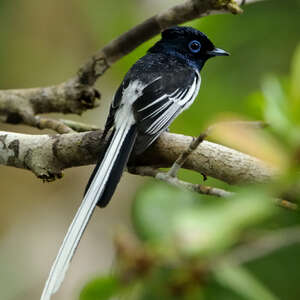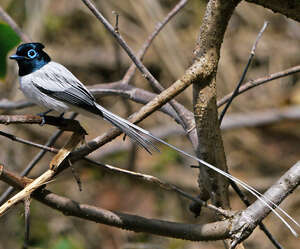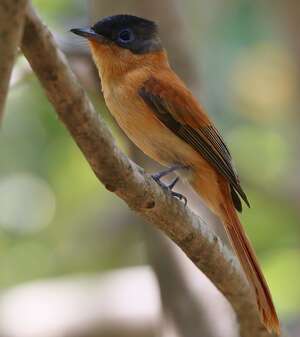Malagasy Paradise Flycatcher
Terpsiphone mutata - Tchitrec malgache
Identification
The Malagasy Paradise Flycatcher has three different plumage variations. For the male there are two distinct morphs. Up to the age of three or four, the male is sexually immature and is in the red phase. The body is almost entirely red with a white bar on the wings, which are black-grey apart from the coverts, which remain red. The beak and legs are grey-blue while the head is covered in a black-blue and glossy cap starting from the base of the beak and extending down to the nape of the neck. There is also a bright turquoise-blue orbital circle which is more visible during mating season and a crest on the top of the nape.
As the males become sexually mature in their fourth year, they enter the white phase. The body and the tail are white, while the back may vary from black to white. The wings are black with a white edging on the remiges. The beak and legs are grey-blue while the head is black-blue, covering the entire head and throat. There is also a bright turquoise-blue orbital circle.
During mating season, for both morphs, the medium rectrices become 20 cm long although they will shed after moulting.
The female is almost identical to the immature male however she does not experience an increase in rectrix length during mating season and her body is entirely red.
In all three plumage variations, the Malagasy Paradise Flycatcher has large vibrissae at the base of the beak.
Subspecific information 5 subspecies
- Terpsiphone mutata mutata (Madagascar)
- Terpsiphone mutata pretiosa (Maore. Mayotte I. in e Comoros.)
- Terpsiphone mutata vulpina (Ndzuani. Anjouan I. in c Comoros.)
- Terpsiphone mutata voeltzkowiana (Mwali I.. Mohéli I. in wc Comoros.)
- Terpsiphone mutata comorensis (Njazidja. Grand Comoro I. in w Comoros.)
Foreign names
- Tchitrec malgache,
- Monarca malgache,
- papa-moscas-do-paraíso-malgaxe,
- Rotbrust-Paradiesschnäpper,
- malgaszi paradicsom-légyvadász,
- Madagaskarparadijsmonarch,
- Pigliamosche del paradiso del Madagascar,
- madagaskarparadismonark,
- Vekselparadismonark,
- vípkar madagaskarský,
- lejskovec madagaskarský,
- Madagaskarparadismonark,
- madagaskarinparatiisimonarkki,
- monarca del paradís de Madagascar,
- muchodławka białoskrzydła,
- Мадагаскарская райская мухоловка,
- マダガスカルサンコウチョウ,
- 马岛寿带,
- madagaskarparadismonark,
- 馬達加斯加綬帶,
Habitat
Behaviour character trait
The Malagasy Paradise Flycatcher is an active yet rather discreet bird that only comes out of its thickets to chase away those who venture onto its territory.
With its crest held high, it chirps out shrill sounds. To feed, it perches itself in high places, searching for insects. Once they've been caught, it returns to its observation post to consume them. It also hunts by slithering and weaving in and out of branches, its wings and tail feathers spread, in order to dislodge any insects there. During the mating period, it is its long white middle rectrices that betray its presence in a tree, like white streamers.Flight
Dietfeeding habits
Reproduction nesting
The Malagasy Paradise Flycatcher nests at a low height in the fork of a tree. The nest, in the form of a deep cup, is made up of twigs and dry grasses. The interior is lined with moss and/or kapok. The female lays three or four white, beige eggs striped with reddish colors. Incubation takes about ten days and is done by both sexes.
Geographic range
The Malagasy Paradise Flycatcher is present in Africa, Asia, Madagascar, the Seychelles, and the Comoros Islands, including Mayotte where it is represented by the subspecies pretosia. The populations of all these islands have evolved in their own way and differently from each other to present their own characteristics. They have become subspecies that some taxonomists now elevate to the level of full species and make them endemic species.
Threats - protection
Sources of information
- IOC World Bird List (v15.1), Gill, F and D Donsker (Eds). 2025-12-07.
- Les Oiseaux de Mayotte, Clément Michel, Grissac Philippe, Rolland Robin
- Oiseaux des iles de l'océan Indien, Langrand Olivier, ian Sinclair
- BirdLife International, BirdLife International
Other sources of interest
 Specification sheet created on
26/07/2023 by Nathalie Santa Maria
Specification sheet created on
26/07/2023 by Nathalie Santa MariaTranslation by AI Oiseaux.net
© 1996-2025 Oiseaux.net
- Accipitriformes
- Aegotheliformes
- Anseriformes
- Apodiformes
- Apterygiformes
- Bucerotiformes
- Caprimulgiformes
- Cariamiformes
- Casuariiformes
- Charadriiformes
- Ciconiiformes
- Coliiformes
- Columbiformes
- Coraciiformes
- Cuculiformes
- Eurypygiformes
- Falconiformes
- Galliformes
- Gaviiformes
- Gruiformes
- Leptosomiformes
- Mesitornithiformes
- Musophagiformes
- Nyctibiiformes
- Opisthocomiformes
- Otidiformes
- Passeriformes
- Pelecaniformes
- Phaethontiformes
- Phoenicopteriformes
- Piciformes
- Podargiformes
- Podicipediformes
- Procellariiformes
- Psittaciformes
- Pterocliformes
- Rheiformes
- Sphenisciformes
- Steatornithiformes
- Strigiformes
- Struthioniformes
- Suliformes
- Tinamiformes
- Trogoniformes































